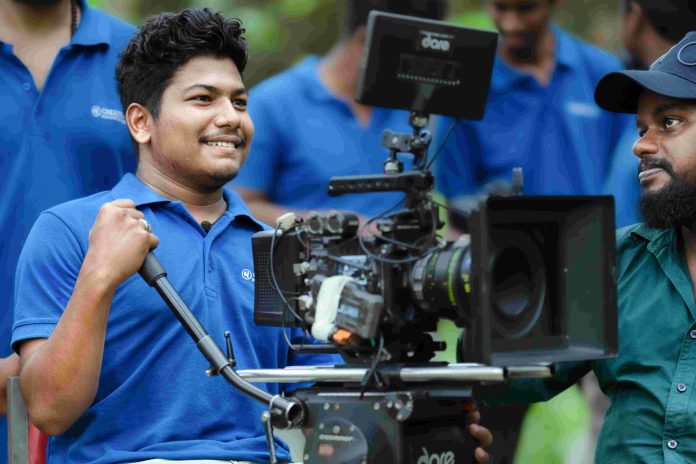The Faces We See Everyday Are Hot In Reality
As night descends and twilight surrenders its multitudes of hues to the enveloping darkness, temple lamps—kalivilakku—glow with thick wicks soaked in pure coconut oil, lighting the stage for the resplendent art form of Kathakali to begin. A stylised version of Indian classical dance drama that originated roughly in the same period when Shakespeare was scribbling his masterpieces, Kathakali riveted the attention of many with its magnificent make-up of characters, elaborate costumes and well-defined body movements.
Noble male characters like as monarchs and divine creatures are shown with the pacha vesham, which is primarily green in colour. These characters have a mix of satvic (pious) and rajsik (kingly) nature. The pious element facilitates immense possibility for the artiste to explicate his acting talents. Characters like Lord Krishna and Lord Rama are examples of pacha vesham. Kathi characters are arrogant and evil but have a streak of valour in them. Though the green make-up denotes that they are high born, artists paint a red mark like an upturned moustache or knife on the cheek to show that they are evil. They also have white knobs on the tips of their noses and on their foreheads, which add to their evil nature. Ravana, the demon king is a typical kathi character in Kathakali.
these in detail.-heading
The Five Principal Makeup Types (Veshams) in Kathakali
There are three distinct types in the class of thadi vesham viz. chuvanna thadi (red beard as in the case of the character Bali – the king of monkeys) vella thadi (white beard) and karutha thadi (black beard). The red beards are vicious and excessively evil characters. Their faces are mainly painted black on the top half and red on the lower.
Artists use the white beard to represent a higher type of being, mainly seen in the character of Hanuman, the monkey god. The black beards are the charac ter types in which black predominates in male-up and costume.
The Five Veshams of Kathakali
These are the early hunters beings like the wild hunters and forest dwellers. Kari vesham is used for demonic characters, portraying the most gruesome figures on the Kathakali stage. Their faces are jet-black with dotted red and white markings on them. Minukku vesham symbolizes gentleness and high spiritual qualities (like saints), which are in sharp contrast to the preceding four classes. In addition to these five primary classes, there are eighteen unique personalities, such as Jatayu, Hamsam, and Karkotaka, whose makeup defies easy classification.
In kathakali there are mainly 5 type of makeup. They are Pacha, Kathi, Tadi, Kari, Minukku, They constitute each and every part of the kathakali. One who want to know about kathakali must know about these in detail.
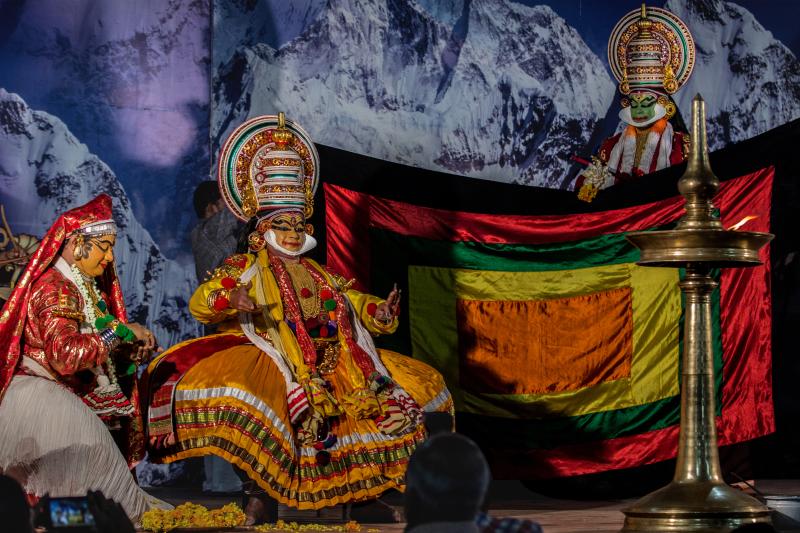
PACHA
The traditional way of dressing up in Kathakali is termed as Ututtu Kettu literally meaning wearing and tying. The performer wears a leather piece with bells, formally called “Kechamani,” around the ankles. They tie small cushions around the hips, over which they wear layered skirts. These anklets are designed to protrude outward, creating a sense of depth. They also hang ornamented tapes, known as “Pattu Vallu,” on both the left and right sides. In front of the skirt, they hang an ornament called “Munthi.” Additionally, they wear a traditional chain around the waist known as “Pati Yaranjan.”
The performer wears a green-colored, back-open jacket above the waist. They also wear breast plates, bangles, and shoulder bangles, along with various kinds of necklaces, and tie a kazhuttara around the neck.
Assembling the Headgear and Garments in Kathakali
The artist next applies Kortam, a makeup-free headpiece, and ties a long, tapering piece of cloth around the head. They place the Bem, a cone-shaped structure with a dark base, behind it. To decorate the Kiritam, they use peacock feathers, imitation pearls, beads, and colored paper. They tie strings to the Kiritam and attach two earrings, known as Chevippoovu, which they then fasten around the head.
The artists use Chaneram, made of jute threads dipped in black paint, to serve as hair that covers the actor’s exposed back, since the kamchukam jacket opens only at the back and leaves that part uncovered. They then place three outer garments called Uttariyam, specially made from long pieces of cloth entwined and tied to resemble fully bloomed lotus flowers, around the neck.
Final Touches of Transformation
The flower like tips of the garments will be provided with small mirrors inside so as to enble the actor to see his face whenever he wants to do so on the stage. Artists fit artificial nails made of silver to the tips of the fingers on the left hand. They apply mica powder—made of very tiny particles—to the face to give it a shining look.
The last and the most important item of the make up is to give a reddish tinge to the eyes. To achieve this effect, the performer slowly inserts the seed of a particular plant called Chunda (Botanical name: Salanani pubescens) into the lower eyelids. By rotating the eyeballs in all directions, the seed settles inside and retains a vivid red color throughout the night. The performer must remove the seed immediately after completing their role on stage.
The Noble Green of Divine and Heroic Characters in Kathakali
Yudhishtira, his four siblings, the other kings of noble characters like Nala, gods and demigods like Mahavishnu, Indra, Kubera, and Daksha, and others of equal stature and nobility all adopt the pacha form of meke up.
A few other characters, such as Lord Krishna and Lord Sri Rama, had minor adjustments made to their makeup and attire. The main change is that Krishna and Rama have to wear a different type of head gear called Muti. The circular disc of the Kirita mentioned before will be absent in a Muti which will be almost like a cylinder with peacock feathers projecting (slightly crimson) for his face instead of green. Still he too is considered to be a pacha type.
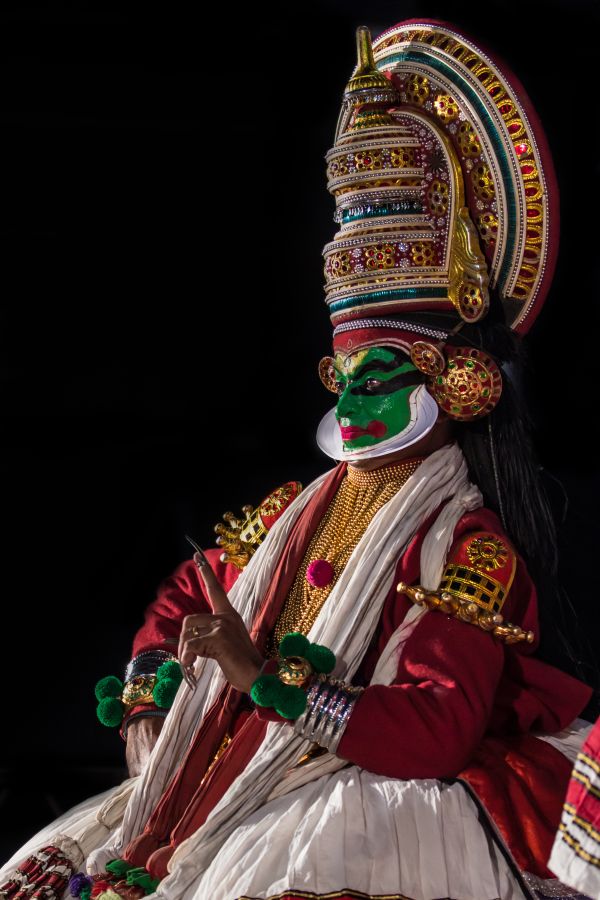
KATHI
The next type is Kathi or knife shaped, deriving its name from a peculiar sort of painting made in the face in the form of the blade of a knife. The white border or Chutti will be slightly bigger in shape and measurement than that of Pacha. There will be two sets of painting in the form of a knife blade, one set just above the eye brows on the fore head the tail end of which encroaches the nose also. The artists create the other set above the upper lip, covering the area where long whiskers or a moustache would appear. They color the knife blade portion deep red.
Kathi Vesham
The artists paste a small globe called Chuttippoo at the tip of the nose to give the character a demonic appearance. They enhance this effect with two artificial canine teeth, which they conveniently manipulate with the tongue to either exhibit or conceal as needed. The other details of make-up and costumes are almost like those oh Pacha. Ravana, Duryodhana, Keechaka, Kamsa, and Sisupalan come under this group.
Pacha type characters are never privileged to open thier mouth or show their teeth at the time of acting. But Kathi have to expose their teeth and produce a roaring sound like “Gvo-gve-e..”.This also adds to their ignoble and demonic.
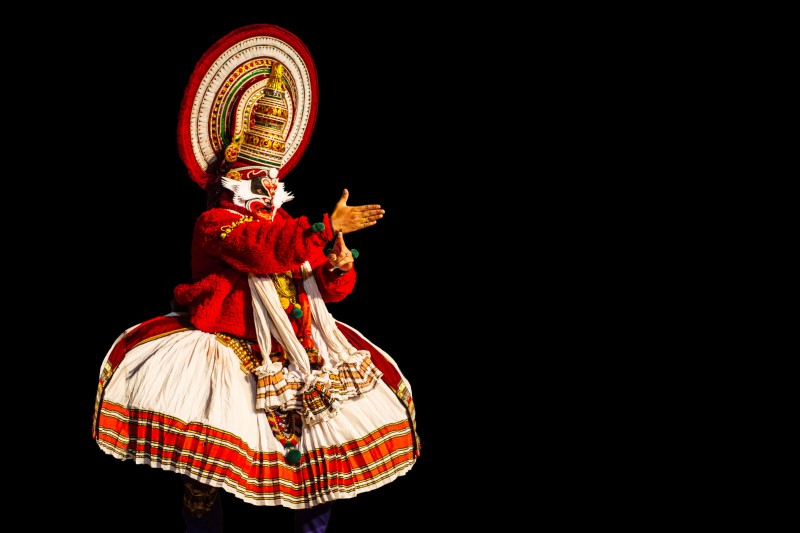
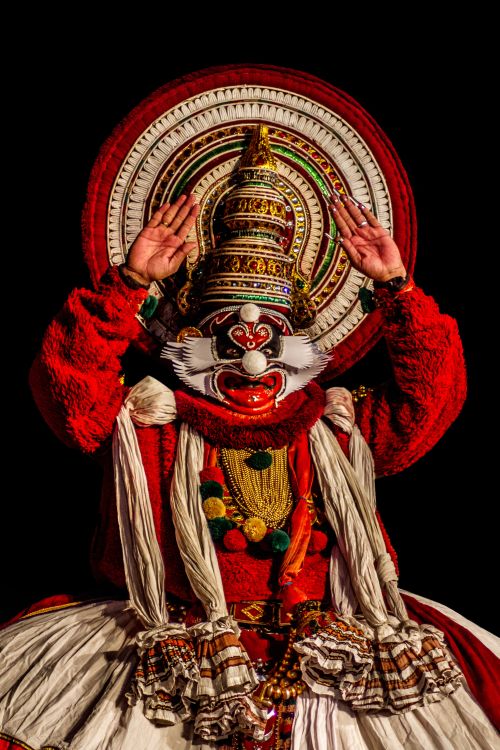
TAADI
Taadi or Beard falls under two main groups,viz. Chuvanna taadi (Red Beard) and vellithadi (White Beard). Chuvanna taadi is more ferocious a type than Kathi. Vellathadi is a mild type with noble features in his character.
CHUVANNATADI
Artists paint the remaining areas deep crimson, while they color the lips and the areas surrounding the eyes jet black. They wind a deep red artificial beard around the cheeks and chin.It serves as a suitable replacement for the Pacha type’s Chutti (White Border).
The Canine teeth and Chuttippoo (the white ball at the tip of the nose) are given to this type also as in the case of Kathi. Chuvanna taadi won’t have the usual bangles worn by Pacha and Kathi: in its place he wears a peculiar type of bangles called “Hasta Katakam” The jacket of taadi is a special kind. Artisans make it from wool, and they design it larger than any other type. They call this jacket the “Potippu Kuppayam.” The Kiritam, or headgear of Taadi, enlarges the type worn by Kathi. In fact, the Kiritam of Chuvanna Taadi is perhaps the largest among all headgears used by Kathakali artists.
Iconic Characters in the Chuvanna Taadi Category
Dussasana, Trigarta, Bali, and kali are a few charac- ters coming under the group of Chuvanna taadi. The jacket of taadi is a special kind. Artists make this jacket from wool and design it larger than any other type, calling it the “Potippu Kuppayam.” They craft the Kiritam, or headgear of Taadi, as an enlarged version of the one worn by Kathi characters. In fact, the Kiritam of Chuvanna Taadi is perhaps the largest among all headgears used by Kathakali artistes. Dussasana, Trigarta, Bali, and kali are a few characters coming under the group of Chuvanna taadi.
VELLATHADI (White Beard) The Monkey-God Hanuman is a vellathadi. His face make-up is different from that of the others stated above. The lips is painted black. The face after make-up will look exactly like that of a monkey. The head-gear is a peculiar one, round and circular in shape with a towering top. They call this headgear Vellamudi, which literally means “round head-gear.” The performer wears a hairy white jacket known as Venchamara Kuppayam. They tie the breastplate, called the Marmala, above the outer garment Uttariyam. The beard is pure white. The Vellathadi character is also privileged to roar and exhibit his teeth during the performance.
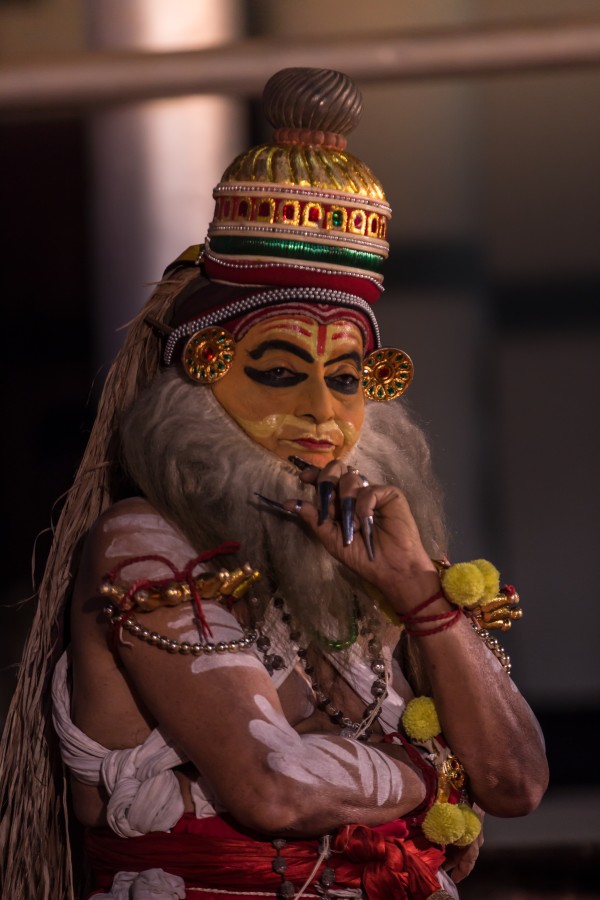
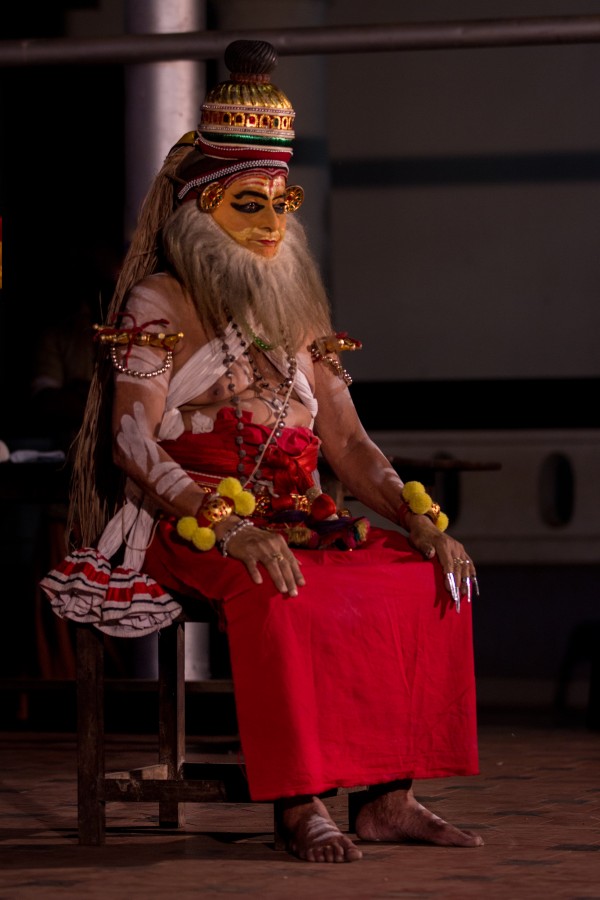
MINUKKU
The makeup artist paints the actor’s face with yellow arsenic, outlines the eyes and eyebrows gracefully with collyrium, and colors the lips with red. For women characters, they do not use a headgear; instead, they create a tuft called “konda” using cloth. Over the konda, they place a silk cloth that resembles a veil and covers the entire back region. After this, they dress the actor in appropriate jackets along with breast plates and other decorative elements. They also adorn the performer with anklets, earrings, and various kinds of bangles.
The Traditional Draping Style
The Ututhu Kettu or wearing of clothe is in a peculiar style.The performer wears a long white cloth around the loin, allowing its plaited end to hang in front. They fix the other end of the cloth at the back, arranging it to flow down and cover the actor’s back.
All queers, goddesses and other noble women including the companions of queens come under this type.
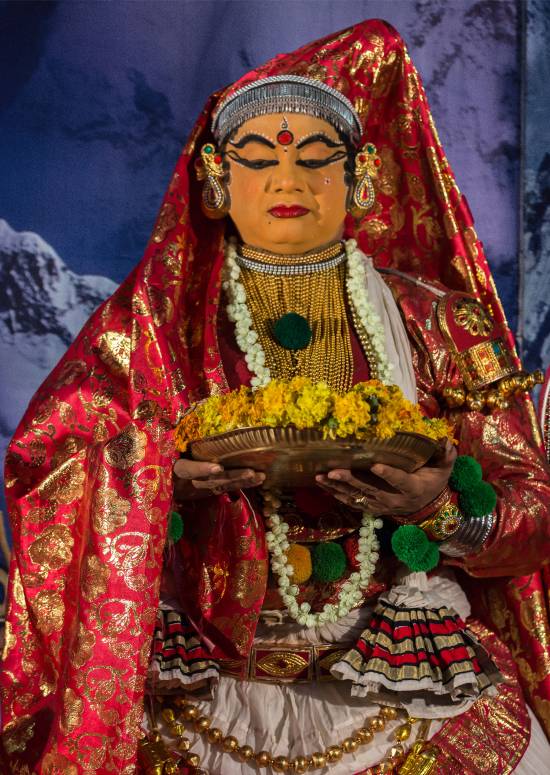
Copyrights: All the photos and text in this post are the copyright of Ramess Rajan and Creative Hut Institute of Photography and film. Their reproduction, full or part, is forbidden without the explicit approval of the rightful owners.


